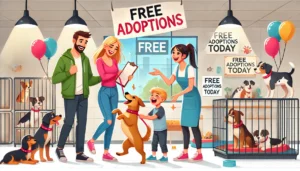How to Adopt a Dog for Free in the USA: A Comprehensive Guide
The thought of bringing a dog into your home is filled with images of joyful greetings, cozy cuddles, and playful afternoons in the park. But the initial cost of adoption can be a barrier for some would-be pet parents. This leads to a common question we see across forums and search engines: “How can I adopt a dog for free?”
It’s a valid question, and the good news is, yes, it is entirely possible to adopt a dog in the USA without paying an adoption fee. However, the concept of a “free” dog isn’t as simple as it sounds. This comprehensive guide is built on years of experience in the animal welfare community to give you the real, actionable strategies to find a fee-waived canine companion and, more importantly, to prepare you for the true journey of dog ownership.
“Saving one dog will not change the world, but surely for that one dog, the world will change forever.” – Karen Davison
What Does “Free Dog Adoption” Really Mean?
Before we dive into the “how,” it’s crucial to understand the “what.” In the world of responsible animal rescue, “free” almost always means the shelter or rescue organization has decided to waive the standard adoption fee. It does not mean the dog hasn’t received extensive care.
A reputable shelter’s adoption fee typically covers a portion of the costs for:
- Spay/neuter surgery
- Age-appropriate vaccinations (Rabies, DHPP, etc.)
- Microchipping and registration
- Deworming and flea/tick prevention
- A wellness check by a veterinarian
- Food, shelter, and daily care
- Temperament testing and behavior modification
When a shelter waives this fee, they are making a strategic decision to encourage adoptions, often for a specific reason. This is a gift from the organization to you, one that can be worth hundreds of dollars in initial veterinary care.
A Word of Caution on “Free” Dogs from Unvetted Sources
Be extremely wary of online ads on platforms like Craigslist offering “free” puppies or dogs. While some may be legitimate rehoming situations, many are scams, backyard breeders trying to offload unsold animals, or individuals getting rid of dogs with serious, undisclosed health or behavioral issues. A fee-waived adoption from a shelter means the dog has been assessed and cared for; a “free” dog from an unvetted source comes with no history, no medical records, and no safety net.
Your Roadmap: 8 Proven Ways to Find Fee-Waived Dog Adoptions
Ready to find your new best friend? Here are the most effective and responsible ways to find a dog with a waived adoption fee in the United States.
1. National Adoption Events (Like ‘Clear the Shelters’)
This is, by far, the most popular and widespread method. Several times a year, national animal welfare organizations partner with local shelters across the country for massive adoption drives. The most famous is NBCUniversal’s Clear the Shelters event, which typically happens in late summer. During this period, thousands of participating shelters will reduce or completely waive adoption fees for all or some of their animals.
How to Participate: Keep an eye on the official Clear the Shelters website, and follow major organizations like the ASPCA and Best Friends Animal Society for announcements. Local news stations often heavily promote these events as well.
2. Local Animal Shelter & Rescue Promotions
You don’t have to wait for a national event. Your local municipal shelter or private rescue is constantly running its own promotions. The key is to stay connected.
- Follow them on Social Media: This is the #1 way to get real-time updates. Like the Facebook and Instagram pages of all shelters within driving distance. They will post about “Adoption Specials” for holidays like Valentine’s Day, St. Patrick’s Day, or the 4th of July.
- Check their Websites: Many shelters have a dedicated “Promotions” or “Events” page on their website.
- Look for Specific Themes: Shelters often waive fees during “Adopt a Senior Pet Month” (November), “National Pit Bull Awareness Month” (October), or for dogs with black fur, who are often overlooked (known as “Black Dog Syndrome”).
3. Adopting Dogs with Special Considerations
Shelters are deeply committed to finding homes for their longest residents or animals that might be harder to place. To incentivize adopters, they will very often waive fees for:
- Senior Dogs (typically 7+ years old): Adopting a senior is an incredibly rewarding experience. They are often already trained, calmer, and so grateful for a soft place to land.
- Bonded Pairs: When two dogs have a strong bond and must be adopted together, shelters will often waive one or both of the adoption fees.
- Dogs with Medical Conditions: This could be anything from a manageable chronic condition like diabetes to a dog recovering from a necessary surgery. The shelter provides the history, you provide the love.
- Long-Term Residents: Any dog that has been in the shelter for an extended period (e.g., over 6 months) may have their fee sponsored by a volunteer or the shelter itself.
4. Military and Veteran Programs
Many organizations recognize the powerful bond between pets and service members. Programs like “Pets for Vets” often have chapters that help match veterans with a suitable companion animal, and many local shelters offer year-round fee-waived adoptions to active-duty military and veterans with valid ID. Always ask your local shelter if they have such a program.
5. Rehoming Directly from a Trusted Source
Sometimes, life circumstances change, and a friend, family member, or coworker can no longer care for their beloved pet. This can be a wonderful way to give a home to a dog with a known history. However, it’s vital to treat it like a formal adoption. Ensure you receive all veterinary records, discuss the dog’s temperament and triggers honestly, and consider a formal transfer of ownership for microchip and vet records.
6. “Foster to Adopt” Programs
Fostering is providing a temporary home for a shelter dog, freeing up kennel space and allowing the dog to decompress in a home environment. Many shelters have “foster to adopt” programs where, if you fall in love with your foster dog (a common occurrence known as a “foster fail”), the organization will often waive the adoption fee as a thank you for your service.
7. Using Online Pet Adoption Databases
Websites like Petfinder.com and Adopt-a-Pet.com are essential tools. While they don’t have a “free” filter, you can use them strategically. Once you find a dog you’re interested in, visit the website of the specific shelter it’s located at. You may discover they are running a fee-waived promotion that wasn’t listed on the national database.
8. Partnering with Local Businesses
Keep an eye out for local businesses that support animal welfare. A local pet supply store, car dealership, or real estate agency might sponsor a weekend’s worth of adoptions at the local shelter, meaning every animal adopted during that time has a $0 fee.
Budgeting for Your New Best Friend: Beyond the Adoption Fee
This is the most critical part of our guide. The adoption fee is a one-time cost, and it’s the smallest expense you will have over your dog’s lifetime. Being a responsible and loving pet owner means being financially prepared. Adopting a “free” dog only makes sense if you can comfortably afford their ongoing care.
Pro Tip: The “New Pet” Savings Fund
Before you even start looking for a dog, open a separate savings account and start putting money aside. A goal of $500 – $1,000 is a fantastic safety net for initial supplies and any unexpected vet visits in the first few months. This single step can prevent immense stress later on.
Here’s a realistic breakdown of costs:
- Initial “Welcome Home” Costs (First Month): $300 – $800+
- High-quality food, collar/harness, leash, ID tag, food and water bowls, crate, bed, toys, grooming supplies, training treats, initial vet wellness check.
- Ongoing Annual Costs: $1,000 – $2,500+
- Food: $400 – $1,000+ (depending on size and brand)
- Routine Vet Care: $250 – $500 (annual checkup, vaccines, flea/tick/heartworm prevention)
- Grooming: $50 – $400 (depending on breed and frequency)
- Pet Insurance (Optional but Recommended): $300 – $700
- Miscellaneous: Toys, treats, training classes, boarding/pet-sitting.
Setting Up for Success: Your New Dog Welcome Kit
Having the right supplies on hand before your dog comes home will make the transition smoother for everyone. We’ve selected some highly-rated, essential items available on Amazon to get you started. Investing in quality basics from the start can save you money in the long run.

MidWest Homes for Pets iCrate
A crate is an essential tool for training and provides a safe, den-like space for your dog. The iCrate is a popular choice for its durability, double doors, and included divider panel for growing puppies.
View on Amazon
Amazon Basics Stainless Steel Bowls
Durable, easy to clean, and non-porous, stainless steel bowls are a vet-recommended choice. This set of two is perfect for food and water and won’t harbor bacteria like plastic bowls can.
View on Amazon
BAAPET 5 FT Strong Dog Leash
A reliable leash is a non-negotiable for safety. This popular leash features a comfortable padded handle and reflective threads for nighttime visibility, providing peace of mind during walks.
View on Amazon
KONG Classic Dog Toy
The KONG is a must-have for preventing boredom and separation anxiety. Its durable rubber construction is perfect for chewing, and you can stuff it with treats or peanut butter for hours of enrichment.
View on Amazon
Bedsure Orthopedic Dog Bed
Give your new companion a comfortable spot of their own. An orthopedic bed provides support for joints, and having a designated resting place can help them feel secure in their new environment.
View on Amazon
Hill’s Science Diet Dry Dog Food
Ask the shelter what food your dog has been eating and try to continue with it to avoid digestive upset. If you’re starting fresh, a vet-recommended brand like Hill’s Science Diet provides balanced nutrition for a healthy start.
View on AmazonThe First 48 Hours: Ensuring a Smooth Transition
Bringing a dog home is exciting, but for them, it’s a massive change. Their entire world has been turned upside down. The key to success is patience and creating a calm environment. This is often called the “Decompression Period.”
- Create a Safe Zone: Set up their crate and bed in a quiet corner of your home. This is their personal space where they can retreat and feel safe.
- Limit Exploration: Initially, keep them on a leash, even indoors, or use baby gates to restrict them to one or two rooms. This prevents them from becoming overwhelmed.
- Structured Introductions: If you have other pets, introductions should be slow, controlled, and done on neutral territory (like a walk outside). Do not force interactions.
- Establish a Routine: Dogs thrive on predictability. Start a consistent schedule for feeding, potty breaks, and walks from day one.
- Puppy-Proof Your Home: Prepare your home by securing potential hazards. Put away electrical cords, secure trash cans, and remove toxic plants. It’s also vital to be mindful of your indoor air quality. Certain household products, like common plug-ins, can be irritating or even toxic, so it’s critical to understand is air freshener bad for dogs? before you bring your new companion into the space.
Your Questions Answered: Dog Adoption FAQ
Why do shelters waive adoption fees? Aren’t they losing money?
Shelters waive fees to save lives. An empty kennel means they can rescue another animal from a high-kill shelter or an urgent situation. The cost of caring for a dog in a shelter long-term far exceeds the adoption fee. Fee-waived events generate community excitement, increase foot traffic, and ultimately result in more animals finding loving homes.
Are dogs from “free adoption” events healthy?
Yes. The standard of care does not change based on the adoption fee. Every dog adopted from a reputable shelter, regardless of the fee, has received a veterinary wellness check, vaccinations, spay/neuter surgery, and other necessary treatments. The shelter has a responsibility to disclose any known medical or behavioral conditions to potential adopters.
What if I can’t afford the ongoing costs of a dog right now?
It’s incredibly responsible to ask this question. If you cannot comfortably afford the ongoing costs, it is best to wait. A dog is a 10-15+ year commitment. In the meantime, you can get your “dog fix” and make a huge difference by volunteering at your local shelter, walking dogs, or becoming a temporary foster home.
How can I increase my chances of being approved for adoption?
Shelters want to see that you are prepared. Show up with a list of thoughtful questions. If you rent, bring a copy of your lease’s pet policy. Talk about how you plan to exercise the dog and what your daily routine will look like. Honesty, preparedness, and a genuine desire to provide a stable, loving home are what adoption counselors look for.
The Most Rewarding Journey
Finding a dog through a fee-waived adoption event is an incredible opportunity to save a life without the initial financial barrier. But the real investment isn’t monetary—it’s an investment of your time, your patience, and your heart. The “free” adoption fee is just the beginning of a journey that will pay you back tenfold in unconditional love, unwavering loyalty, and a bond unlike any other.
You are not just getting a dog; you are giving a deserving animal a second chance at the life they’ve always dreamed of. Good luck on your search—your new best friend is waiting for you.


